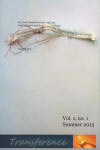Transference – Summer 2013
I’m going to refer to this publication as a “class in a book” for its incredible depth and breadth of content (in only 78 pages); ambitious would be an understatement. Transference is a new journal of poetry in translation published by the Western Michigan University’s Department of World Languages and Literature, which includes Arabic, Chinese, French, Old French, Classical Greek, Latin, Japanese, and Russian.
I’m going to refer to this publication as a “class in a book” for its incredible depth and breadth of content (in only 78 pages); ambitious would be an understatement. Transference is a new journal of poetry in translation published by the Western Michigan University’s Department of World Languages and Literature, which includes Arabic, Chinese, French, Old French, Classical Greek, Latin, Japanese, and Russian.
In addition to publishing English translations, each work is accompanied by commentary from the translator, which may include background on the poet, historical context, choices made in translating specific words, choices made in “translating” the poetic form, and general analytical commentary on the poem itself as well as poetic form. In other words: Class in a book.
Missing from the volume are the original language poems, always a tough call for translation editors to make. Does it add to the reader’s experience to include these? If the reader knows the language, certainly. But, practically speaking, it also adds a great deal to the cost. I don’t mind not having the original included, as the editors note: “We encourage our readers to seek out the original poems in the original languages.” Sure enough, a quick Internet search of a couple landed them on my screen.
Reading each poem is like taking a unique trip through geography and history. Andrew Gudgel focuses on “lesser-known” dynasty poets of China, while Roselee Bundy gives her examination of Fujiwara Shunzei’s thirty-one syllable Japanese waka poems from the 1100s, and several other translators take readers through Germany in the late 1800s and 1940, Russia, France, to current day Iraq.
There is an inconsistency in the commentary information each translator offers, which can be acceptable or irritating depending upon expectation. Some provide simple background information on the originating author and cultural context, while others just dive into a discussion of their work of translating. So this content feels uneven in the sense of sometimes seeming to want to fully educate the reader on culture and context and sometimes just wanting to discuss and defend the translator’s work. I personally appreciated having the fuller content, being hungry to learn about these poets and their lives. Certainly, readers can seek out this information, but having it as an all-encapsulated start point is handy. (Class in a book.)
The poems precede the translators’ notes, which works well for readers. Read each poem—no deeper context of information—then read the translator’s comments, then go back and reread the poem. This in itself offers an exercise in reflection, as no doubt re-reading the poem offers a new and different experience. Better? That’s for the reader to decide. Certainly having some cultural context helps to understand parts/the whole of the poem, and having some insight into the work of the translator allows for reconsideration, even mental argument, with how s/he may have chosen to work with the poem.
In some cases, I was more perplexed after reading the translator’s notes, as in Levi Thompson’s translation of Sa’d? Y?suf’s poem “Condoleezza Rice’s Piano,” which begins, “Hey, ho Bob Marley / O Bob Marley / How do we stop that train?” Thompson explains the poem “brings to mind the defiance of early punk rock anthems,” so he attempts “to intertextually evoke the rebelliousness of that genre by making reference to the line ‘Hey! Ho! Let’s go!’ from the Ramones’” song. I’m guessing he was working with a line that couldn’t be directly translated, or was he taking a greater liberty in attempting to insert a rallying cry that would be more readily recognizable by the reading audience while keeping it in the context of style of Y?suf’s writing (“percussive, chopped verse bursts out onto the page”)? This was among the briefest commentaries in the collection, which may be translator’s choice, but could have used a bit more editorial coaxing to get more information like so many of the others. A consistency issue perhaps.
Other translators provide greater context for their work, creating arguments that read almost like a threaded discussion throughout, such as Maryann Corbett’s statement: “In translating a medieval poem for a modern audience, the first decision has to do with form. Should the translator’s first concern be with making the text as attractive as possible to the widest range of readers in the target language?” John Perry seems to answer this (albeit six pages earlier): “It is the test of validity: if the translator can’t at least simulate the packaging, then the whole undertaking is mere plagiarism.”
Lucky readers, all the works published in Transference are available on the publications website. Great for classroom instruction, great for self-instruction. Works in translation, commentary and analysis—Transference is not only a bridge between poets and translators, but an effort which wholly engages readers in the process.
[scholarworks.wmich.edu/transference]





